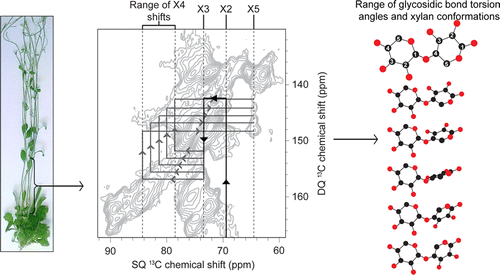Plant cell structure discovery could lead to improved renewable materials

The step forward follows research by the Universities of Warwick and Cambridge and the unexpected discovery of a previously unknown arrangement of molecules in plant cell walls.
The paper describing this work was Editors' Choice for the American Chemical Society for March 25th.
The researchers investigated the polymer xylan, which comprises a third of wood matter.
Professor Ray Dupree from the University of Warwick, one of the research's authors, says: "Using advanced NMR techniques we found that the xylan polymer, which comprises about a third of wood, has an unexpected shape inside the plant cell walls".
The structure of the xylan was ascertained by creating 2D maps of the molecular structure of the woody stalks of thale cress in the UK's most advanced solid-state Nuclear Magnetic Resonance (NMR) Facility, based at the University of Warwick.
Professor Paul Dupree of the University of Cambridge (son of Professor Ray Dupree) says "For the first time we have been able to study the arrangement of molecules in woody plant materials. Plant cell walls provide the mechanical strength to plants. This major step forward in understanding the molecular architecture of plant cell walls will impact the use of plants for renewable materials, energy and for building construction".
Professors Ray and Paul Dupree have discussed the possibility of working together to solve outstanding questions in plant biochemistry for twenty years. Only recently has it become possible due to the ability to grow suitable experimental plants at the University of Cambridge and the availability of the powerful NMR facility in Warwick.
Commenting on the use of the NMR Facility, co-researcher Professor Steven Brown of the University of Warwick says:
"The NMR Facility is a flagship national success for shared equipment and multi-disciplinary research. Since its launch it has contributed to a broad range of ground-breaking research and we look forward to continue doing so in the years ahead.
"NMR spectroscopy is a vital analytical tool across science. It is a powerful technique that can provide detailed information on the three-dimensional structure and dynamics of molecules in solution and the solid state."
The research, Probing the Molecular Architecture of Arabidopsis thaliana Secondary Cell Walls Using Two- and Three-Dimensional 13C Solid State Nuclear Magnetic Resonance Spectroscopy, is published in the journal Biochemistry.
More information: "Probing the Molecular Architecture of Arabidopsis thaliana Secondary Cell Walls Using Two- and Three-Dimensional 13 C Solid State Nuclear Magnetic Resonance Spectroscopy." Biochemistry, 150325080043005. DOI: 10.1021/bi501552k
Journal information: Biochemistry
Provided by University of Warwick



















